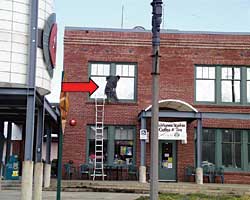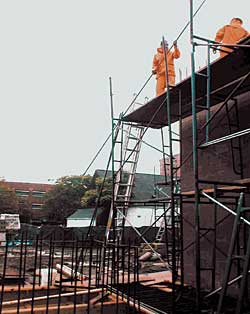
Know Your Threshold
Not for pain or anger management, of course, but for fall safety.
"It's not the faul that hurts -- it's the suddent stop." I read the preceding statement while performing a simulated OSHA inspection. Most fall-related injuries result from the lack of fall protection. Additional injuries occur from improper use of fall protection—utilizing a body belt instead of a full body harness, improper use of lanyards, or utilizing an inadequate anchorage point. Falls from heights of 10 feet or greater almost always result in serious injuries or death. It is important to note, however, that serious injuries and fatalities also commonly occur from fall heights of 10 feet or less.
Consider the following example. After retiring as chairman of the Joint Chiefs of Staff, General Henry Shelton fell approximately 10 feet from a metal ladder while trimming an oak tree outside his house. Attending physicians were doubtful that Shelton would ever walk again. It’s ironic that a former paratrooper who made 400 jumps without incident, some from 20,000 feet at night, was nearly paralyzed from a fall off a ladder!
OSHA lists falls as one of the leading causes of traumatic occupational death, accounting for 8 percent of all occupational fatalities from trauma. An OSHA study involving 99 fallrelated fatalities suggests virtually all of those deaths could have been prevented by the use of guardrails, body harnesses, safety nets, covers, or other means that would have reduced employees’ exposure to the fall hazard.
Fall Protection Thresholds
OSHA has several thresholds for fall protection that are dependent upon the work activity involved. These thresholds are discussed in 29 CFR OSHA 1910 (General Industry) and 29 CFR OSHA 1926 (Construction). A review of these thresholds is in order:
General Industry: 4 Feet
OSHA’s 29 CFR 1910.23 (c)(1) requires open-sided floors or platforms 4 feet or more above adjacent floor or ground level to be guarded by a standard railing (guardrail) or equivalent. The standard railing shown on page 60 is equipped with a top rail, mid rail, and toe board. However, the standard railing needs to be extended to adequately protect employees.
Construction: 6 Feet
OSHA’s 29 CFR 1926.501 (b)(1) requires each employee on a walking/working surface with an unprotected side or edge 6 feet or more above a lower level to be protected from falling by the use of guardrail systems, safety net systems, or personal fall arrest systems. 29 CFR 1926.502 (d) prohibits the use of body belts for fall protection. A body belt may only be used as a positioning device where free fall potential is no more than 2 feet. The picture on page 60 shows an employee working on a windowsill without any fall protection.
 Scaffolds: 10 Feet
Scaffolds: 10 Feet
The OSHA General Industry standards contain a scaffold standard (29 CFR 1910.28: Safety Requirements for Scaffolding). However, the vast majority of scaffold work is considered construction work and is covered by 29 CFR Part 1926 Subpart L—Scaffolds. OSHA’s 29 CFR 1926.451 (g)(1) requires that each employee on a scaffold more than 10 feet above a lower level be protected from falling to that lower level. The scaffold above is greater than 10 feet and is not equipped with fall protection. Also, proper scaffold access has not been provided.
Portable Ladders: Working Height of Ladder
Employees may work on an extension or step ladder up to the maximum working height of the ladder as specified by the ladder manufacturer. It is not permissible, however, for an employee to work on a portable ladder on an elevated surface, such as a roof, and be exposed to a fall height of the ladder and the height of the roof
Fixed Ladders: 20 Feet
OSHA’s 29 CFR 1910.27 (d)(1)(ii) requires safety cages or ladder safety devices on all fixed ladders more than 20 feet to a maximum unbroken length of 30 feet. An example of a safety cage is shown here.
Steel Erection: 15 Feet
Steel erection is considered construction work and is therefore regulated by OSHA’s 29 CFR Part 1926 Subpart R— Steel Erection. 29 CFR 1926.760 (a)(1) requires all employees (except connectors) engaged in steel erection with an unprotected side or edge of more than 15 feet to utilize adequate fall protection. 29 CFR 1926.760 (b)(1) requires connectors (workers who connect the steel to the frame) to utilize fall protection when working above a lower level of two stories or 30 feet, whichever is less. An example is shown in the photo to the right of this paragraph.
Summary
A fall protection survey should be performed to identify potential fall hazards. A fall protection policy should then be developed and employees trained as needed.
This article originally appeared in the July 2007 issue of Occupational Health & Safety.